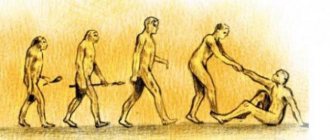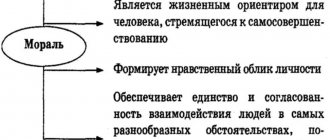Increasingly, news appears in the news and on the Internet about the cruelty of teenagers, attacks, beatings and hooliganism, and the indifference of others. The older generation says that young people have become spoiled and have lost their values. In fact, the phenomenon of anomie (the destruction of moral and moral values) has been known since 1893. It applies to the whole society, but teenagers are at particular risk.
What is anomie
The name is derived from the French word anomie, which means lawlessness, lack of norms. The concept of anomie in sociology was introduced by the French sociologist E. Durkheim, and later his ideas were developed by the American sociologist R. Merton. According to the definition of anomie from Wikipedia, social anomie is a state of society in which there is a destruction of social norms and institutions, instability and uncertainty of human actions, fragmentation of social systems, contradiction of social goals and the means available to people to achieve them.
The concept of anomie at the individual level (psychology) is somewhat different. This is a psychological state of an individual in which there is demoralization of values, loss of connection with society, a feeling of alienation, uselessness, and meaninglessness of life. It seems to a person that there is no place for him in the world. The world does not understand him, and he does not understand the world. Anomie causes depression, suicide and deviant behavior. We'll talk more about this at the end of this article.
Norms and anomie
Social norms are a lever that regulates people's behavior. This category includes official laws, unspoken rules and regulations, and expected behavior approved by society. Norms are a kind of templates that tell a person what to say, think, feel, and do in certain situations and conditions. Fulfillment of social norms is an obligation, a duty of one individual to all others.
What is anomie in society? Anomie is the denial and/or disregard of social norms of behavior. This leads to the destruction of society. The longer anomie persists, the more difficult it will be to restore the structure of society. Old traditions and connections are broken, new ones are not created. People become asocial and suffer from desocialization. They are concerned about their personal lives and are guided by their own interests.
Examples
In a state of anomie, a person suffers from a contradiction between expectations and reality, from the inability to achieve a goal by generally accepted means. The individual finds himself in a state of social crisis.
Examples of anomie:
- the desire for wealth, a carefree life and attempts to achieve this by fraud in real life and on the Internet;
- the desire for fame and attempts to gain it through provocative videos on the Internet.
We see and hear private examples of anomie every day: attacks, robberies, beatings captured on video and broadcast on the Internet, public copulation, indifference of passersby and much more. At the individual level, anomie is felt as uncertainty about the future, loss of meaning in life, focus on survival, serving the allotted days; at the social level – social unrest.
E. Durkheim's theory of anomie and modernity
HOME > Return to contentsSociodynamics
Correct link to the article:
Napso M.D.
— E. Durkheim’s theory of anomie and modernity // Sociodynamics. – 2021. – No. 2. – P. 22 - 30. DOI: 10.7256/2409-7144.2017.2.19456 URL: https://nbpublish.com/library_read_article.php?id=19456 Napso Marianna Davletovna
Doctor of Sociological Sciences, Candidate of Philosophy
Professor, North Caucasus State Humanitarian and Technological Academy
369000, Russia, Cherkessk, lane. Odessky, 5
Napso Marianna Davletovna
Professor, the department of Philosophy and Humanitarian Disciplines, North Caucasian State Humanitarian Technological Academy
369000 Russia, Cherkessk, Pereulok Odessky 5, unit #88
DOI:
10.7256/2409-7144.2017.2.19456
Date the article was sent to the editor:
12-06-2016
Publication date:
16-03-2017
Annotation:
The object of consideration of this article is the phenomenon of anomie, and the subject is the theory of anomie by E. Durkheim and its modern interpretation.
The author examines the specifics of the historical and sociocultural contexts leading to the emergence of anomie. The features of transition periods are considered, the instability and inconsistency of which result in a mismatch of value and ideological attitudes. Factors favoring the expansion of the space of anomie are analyzed, and its negative impact on the manifestations of individual and collective consciousness is traced. Attention is paid to the study of the connection between anomie and deviation. The analysis of the social nature of anomie and the consequences it causes is based on concrete historical, dialectical, systemic approaches, principles of objectivity and integrity. The scientific novelty lies in the substantiation of the thesis about the complex nature of anomie and the factors leading to it. The problematic nature of the issues under consideration allows us to come to the following conclusions: 1) expanding the space of anomie requires the use of an interdisciplinary approach in its study; 2) the study of the risks of anomie is of particular relevance. Key words:
anomie, social anomie, value anomie, alienation, marginalization, deviation, mechanical solidarity, organic solidarity, disintegration, destruction
Abstract:
The object of this research is the phenomenon of anomie, while the subject is Émile Durkheim's theory of anomie and its modern interpretation. The author examines specificity of the historical and sociocultural contexts that lead to the emergence of anomie. The peculiarities of transitional periods, instability and contradiction of which results in incompliance of the value and worldview orientations are being reviewed. The article analyzes the factors that prosper the expansion of the space of anomie, as well as traces its negative impact upon the manifestation of individual and collective consciousness. Attention is given to the connection between the anomie and deviation. The scientific novelty consists in substantiation of thesis about the complicated nature of anomie and factors that lead to it. The author makes the following conclusions: 1) expansion of the space of anomie requires using the interdisciplinary approach in its research; 2) special relevance achieves the study of the risks of anomie.
Keywords:
organic solidarity, mechanic solidarity, deviation, marginalization, alienation, valuable anomie, social anomie, anomie, disintegration, destruction The problem of anomie is one of the most discussed by modern scientific knowledge, including social-philosophical and sociological [1]. Deep transformations of the social structure of modern societies lead to the expansion of the space of dividing lines - economic, political, social, cultural, which in many ways become the cause of various kinds of destruction, which inevitably actualizes the problem of analyzing the social nature of anomie. The need to study anomie is associated with the risks it causes, which make modern societies less stable, and the processes occurring in them more and more chaotic. The weakening of social solidarity relations, the strengthening of disintegration tendencies, and the growth of generally negative manifestations are observed everywhere. Since the processes of social stratification and social differentiation tend to expand, anomie in such conditions becomes one of the self-producing factors, which creates objective preconditions for the emergence of social pathologies of various kinds that threaten the integrity of society.
Having introduced the concept of anomie into scientific circulation as a phenomenon associated with a crisis of values and their inconsistency, E. Durkheim studied the processes of social disorganization characteristic of transition periods, which result in social destruction and various forms of deviant and delinquent behavior. In the absence or decline of moral imperatives, which are the result of the transition from mechanical to organic solidarity, social threats arise, which the scientist paid close attention to in his work “On the Division of Social Labor.” The consequence of the incompleteness of this transition, according to the researcher, is the loss of collective forms of life, the destruction of the patriarchal-communal structure, the loosening of the foundations of a social order established for centuries, the establishment of a new worldview and a different value system.
The processes of formation of bourgeois social relations, which led to transformations of socio-economic, political-cultural and value-worldview nature, changed the way of life of archaic societies, filled the concepts of responsibility and freedom with a new meaning, corresponding to the time and its imperatives. Mechanical solidarity as a type of social connection and social interaction, coupled with the dominance of a centuries-old tradition that limited the limits and possibilities of social development, gave way to organic solidarity, demanded by the capitalist mode of production, the development of which presupposed and required overcoming the rigidity of prescribed norms and rules. The weakening of the bonds of mechanical solidarity was also facilitated by the fact that many social institutions ceased to be fundamental mechanisms of influence.
Religion was losing its role as an all-encompassing ruler, which, in the conditions of transition from one stage of socio-economic development to another, “encompasses an increasingly diminishing part of social life. At the beginning it extends to everything that is social, religious; both words are synonyms. Then, little by little, political, economic, and scientific functions are liberated from religious ones, established separately and given an increasingly… secular character. God..., who was present in all human relationships, moves away from them; it gives more space to the free play of forces. The individual feels less like a person who is forced to act; he becomes more a source of spontaneous activity. ...The area of religion not only does not increase in parallel with the area of worldly life, but is increasingly shrinking”[2].
The spirit of corporatism characteristic of various craft associations is also losing its impact. In a traditional society in which mechanical solidarity prevails, “the worker lives everywhere with the owner, sharing his labors “in the same shop, at the same machine.” Both formed part of the same corporation and led the same existence. “Both are almost equal...” With the division of labor, “the workshop is no longer a common refuge, it is the exclusive property of the owners, who alone manage their affairs... Since then, a deep demarcation line has been established...”. With social advancement, E. Durkheim believes, “the ties connecting the individual with his family, with his native land, with the traditions bequeathed by the past, with the collective customs of the group are weakened. More mobile, he changes his environment more easily, leaving his own people to go live a more autonomous life elsewhere”[2]. It should, however, be recognized that the attachment to the clan, guild, and class inherent in traditional society led, on the one hand, to an existence in isolation, which, despite all the costs, ensured stability and confirmed the expediency of traditional and proven forms of life; on the other hand, the rigid organization of the life process constrained development, which required change.
In the situation of transition from a traditional society to a modernizing one, which is capitalism, the established order is disrupted, dysfunctionality acquires comprehensive features, and the stability and homeostaticity characteristic of an archaic society give way to chaotic states. As a result of these processes, disintegration prevails over integration. The traditions of collectivism and feelings of solidarity were replaced by relationships based on the ideology and psychology of individualism, which resulted in the loss of the individual’s meaning in life. A conflict of interests arises between the growing classes and the “old” structure, which reaches its culmination during the transition period, the expression of which is anomie.
The scope of economic and entrepreneurial activity, which largely undermined the foundations of mechanical solidarity, thereby weakening the specificity of traditional society, which gave way to production relations of a different kind, could not but lead to anomie, the form of expression of which was the processes of social disunity and disorganization. The communal worldview with the system of moral principles inherent in it, which continued to dominate the public consciousness, did not correspond to either the spirit or the speed of economic transformations. The integrity of the individual, which was supported by this worldview, was seriously undermined under such conditions. The emergence of the bourgeois world with its objective demands for organic solidarity, individualization, expanding the scope of freedom, overcoming the isolation of existence, weakening attachment to a locus, and the rigidity of social hierarchies was accompanied by an increase in the space of manifestations of anomie. Despite the fact that with the advent of capitalism, favorable conditions were formed for the division of social labor, which undoubtedly opened up broad prospects for social development - individual and collective, disintegration tendencies became inevitable. As a result of such and many other phenomena, society turns out to be socially split, its integrity and unity are violated, and in such circumstances anomie becomes its inevitable companion and attribute.
The development of capitalism was accompanied by the establishment and use of rationalized, formalized practices, which, displacing informal ways of organizing life, contributed to the successful organization of a system of social relations. The archaic normative system is being replaced by a new one, corresponding to the complexity of economic and political development, which results in a conflict between institutionalized forms of social interactions that have not yet established themselves and the old ones, which are no longer effective enough from the point of view of regulation. A closed society, characterized by the dominance of unchanging, static forms of life, a generally immobile social structure, limited social mobility, and a fairly conservative system of moral and ethical values, was replaced by an open one. The formation of the latter, caused by the development of bourgeois relations, was accompanied by the intensification of processes, the significance of which for social development turned out to be more than productive. Society became more and more democratic, socially mobile, and the limited perception of the world was replaced by ideological and ideological pluralism. On the one hand, this expanded social horizons, as a result of which individuals and groups of individuals could more freely make their own choices, weighing them against the system of their own moral principles, and this resulted in the emergence of greater opportunities for creative self-realization. The response to the situation of transition from a traditional society to an industrial one included anomic manifestations that were found with varying degrees of intensity in all segments of society. And although overcoming the boundaries of the former, closed existence made it possible to minimize the negative impact of anomie, the development of capitalism was associated with its reproduction.
E. Durkheim drew attention to the features of the socially differentiating characteristics of industrial society, which give social processes a chaotic character, and social states, connections, interactions, etc. - contradictory features. In such conditions, the manifestations of anomie are predetermined: the risks of social disorganization, and in many cases, destruction, multiply. The scientist saw the reason for such social manifestations in the processes of social alienation to which the organization of the social division of labor led. But social alienation can be the result not only of economic transformations, but also of a discrepancy between the imposed or dominant system of moral values and the worldview of an individual. Personal disorientation occurs, and the way out of a situation of uncertainty can and often becomes either social alienation or withdrawal into oneself as a result of disintegration - external and internal.
Social alienation can appear in various forms of deviant, anomic behavior, to which E. Durkheim attributed the phenomenon of suicide, the causes of occurrence and specificity of the action of which he associated with manifestations of not so much an individual-personal, but a social nature, and this despite the analysis of extra-social factors leading to suicide. The prevalence of the latter occurs, as the researcher believed, during periods of social transformations and upheavals of a moral and ethical nature. Considering suicide (egoistic, altruistic, anomic) as a social fact, the researcher sees its cause in the destruction of social ties, weakening of mechanisms promoting social interaction, which results in a negative impact of the social environment on the consciousness and behavior of individuals.
The type of suicide, according to E. Durkheim, depends on the nature of the relationship between the individual and society. In a situation of weakening relations of solidarity, a violation of unity with society, egoistic suicide occurs: “if the ties connecting a person with life are broken, this happens because his connection with society is weakened”[3]. Excessive pressure and restriction of freedom create the ground for altruistic suicide: “when a person is separated from society, the thought of committing suicide easily arises in him; the same thing happens to him in the case when the public completely and completely absorbs his individuality”[3]. As for anomic suicide, it is a consequence of the weakness of regulatory norms, which can lead to the choice of deviant forms of behavior as normative ones: “at a moment of social disorganization..., during a period of favorable, but... sudden social transformations, society turns out to be temporarily unable to exert the necessary influence on person"[3]. With all the differences that exist between different types of suicide, the reasons leading to its commission are seen by E. Durkheim in such phenomena as social apathy, social hopelessness, social loneliness, which complicate the processes of adaptation to changed and changing living conditions, resulting in suicide.
The societies of the post-industrial era did not escape anomic manifestations. The speed with which modern social processes unfold, as well as their contradictory content, create conditions for the reproduction of social anomie. Among the reasons of the first order, factors related to the economic sphere should be highlighted, which was noted by the French researcher, who considered anomie in the context of contradictory processes associated with the division of labor, and this gives his thoughts a modern sound. Modern trends demonstrate the uneven development of the economy, the expression of which is the poles of wealth and poverty, and this gap is increasingly widening in most countries. Economic instability, the low level and quality of life of the main part of the population, the expansion of the space of economic stratification, the insufficiency of material and financial resources to ensure a more or less acceptable lifestyle, the inability to satisfy the needs that are offered in abundance by a consumerist society, and much more favor the development of anomie, manifested in in a variety of forms - from the economic proper to the professional and moral.
Society reacts especially sharply to manifestations of economic deprivation, manifested in the unfair distribution of material resources, which limits the level of needs of certain groups of the population, on the one hand. On the other hand, it is insufficient consumption or forced abandonment of the material needs and the necessary set of social services necessary for the development of the individual. In a situation of deprivation - real or imaginary, formed under the influence of both objective conditions and subjective sensations (the so-called relative deprivation), a conflict between social reality and social expectations (between what individuals want and what they have) arises states close to anomic.
Economic deprivation, and therefore anomie, is found in various forms of poverty and social disadvantage. And this is facilitated not only by the low level of material wealth, to which the individual reacts painfully, but also by the lack of demand in the labor market for knowledge and skills, the inability to fully realize one’s talents, in other words, dissatisfaction in the fulfillment of basic needs, including the need for self-expression and self-identification. Feelings of social uselessness, disadvantage, abandonment are formed, which results in unevenness of the socialization process, weakening of sociability, and the emergence of such “alternative” social phenomena as social outcast.
Social anomie arises as a result of social, or more precisely, “multiple” deprivation. A significant role in expanding the space of anomie is played by the processes of deepening social differentiation, the form of expression of which is inequality, in which individuals and groups of individuals are at different levels of the social hierarchy, and the social gap separating them deepens, becoming a symbol of social disadvantage. This includes unequal access to the basic benefits of life, unequal chances for self-realization, unfair remuneration, etc. With the deepening of inequality, the scale and volume of the middle layer are decreasing, and the share of the poor population in the social structure of most modern states is increasing. The indicators of the pre-bottom also turn out to be high, which includes those segments of the population, or social outsiders, who have a fairly high risk of social decline. With the increasing factors of inequality and wealth stratification, which create a wide area of social injustice, the risks of anomic manifestations also increase. The competition inherent in a market economy not only does not weaken, but takes on the most unexpected forms. Property problems in the broad sense of the word give market competition an extremely contradictory character, as a result of which social inequality deepens, becoming a source of anomie. Not the least important role is played by stratification criteria, which are also indicators of social well-being or ill-being. The connection between anomie and socio-economic status is obvious, and this is confirmed by the results of sociological research: the highest percentage of people who commit deviant and delinquent acts belong to the lower strata. Social inequality, which also appears in the form of differentiation of social statuses, is one of the reasons for anomic behavior.
Under transit conditions, the space of social and moral alienation expands. A kind of “breakdown” occurs in the normative value system due to the fact that old ideals and norms have been destroyed, and new ones are at the stage of formation. The formed “junction” of times leads to marginalization and “vacuumization”, as a result of which the conflict of the individual with society becomes inevitable, and the processes of adaptation to rapidly changing environmental conditions become increasingly difficult. The result is manifestations of value nihilism, adherence not to generally accepted norms, but to norms that meet individual and collective needs. The ethical tradition is being eroded, its content is filled with pseudo-meanings, and attitudes of falsely understood pragmatism are being formed. Uncritical perception of ethical attitudes thus formed leads to deformations and deviations of various contents, creating conditions for deprivation - individual and group. As a result of these and the combined effect of many other factors, including the weakening of the control function of the state and its institutions, anomie acquires the features of universality, which confirms the presence of social pathologies.
Anomie in the personal dimension manifests itself in a rather contradictory way: on the one hand, it complicates the processes of adaptation to the rapidly changing socio-historical context, which leads to a cumulative effect (negative manifestations increase according to the “snowball” principle), and on the other hand, phenomena deviating from the norm are perceived by many as socially approved, moreover, as an opportunity for successful integration into society. A situation arises when anomic behavior during such periods becomes a factor that largely determines the vector of life aspirations. As a result of such involution, or substitution of concepts, a shift in emphasis occurs: the norm is replaced by a pseudo-norm, justice - by pseudo-justice, truth - by lies, etc. Following quasi-moral guidelines dooms society and the individual to self-destruction and degradation, and therefore makes it possible for social foresight, in including in matters of overcoming the consequences of anomie, which are quite illusory.
Processes of personal disorientation, accompanied by loss of identity and self-identification, lead to internal disorganization. These are states of individual anomie, which is a logical consequence of social anomie as a whole: processes occurring at the macro level are projected, as is known, onto the micro level, causing consequences of both general and specific properties. The crisis state of society leads - when objective and subjective factors coincide - to personal disorganization, violation of generally accepted norms, devaluation of values, and the spread of deviation, which is considered by many as a norm that ensures the success of social adaptation. Social anomie is also accompanied by a crisis in the cultural sphere, when the process of developing and transmitting cultural norms and values turns out to be difficult, not least due to the weakness of the integrating and regulating functions of culture.
An important role is also played by the insufficiency of internalization mechanisms that ensure the “passage” of socialization through the formation of an internal “I” aimed at rejecting cultural norms of an anomic nature. In a situation where individual and collective consciousness is engulfed by socio-pathological ideas about what should be, when the anti-norm acts as a value setting, threats arise for society as a whole, and there are many examples of this. The value-normative system is collapsing, and the space of deviant manifestations is expanding. With the weakness of the mechanisms of social control - internal and external, thanks to which the integrity and stability of cultural norms are ensured, asociality acquires threatening proportions: the imperativeness of socio-cultural attitudes is replaced by requirements of a pragmatic nature and expediency, understood as compliance with the historical moment and economic situation.
In the flow of time and in a situation of uncertainty of goals, largely due to the competitive struggle unfolding in all segments of society, a conflict occurs between the individual and the external environment and with himself, and this inevitably leads to anomie. This is also facilitated by the fact that the very structure of society in all its subsystems is permeated by it, acquiring the features of all-inclusiveness. Anomic chaos and associated negative processes of various kinds form a wide space of social destruction, when freedom in all its diversity - as the possibility of choice and self-expression, active social action focused on self-affirmation - turns out to be extremely limited.
Bibliography
| Other publications by this author |
| . | Napso M.D., Anomie as a risk factor // National security / nota bene. 2015. No. 5(40). pp. 762-767. |
| . | Durkheim E., On the division of social labor [Electronic resource]. URL: http: // www.ckp.ru/biblio/d/dur_labour.htm (date of visit: 04/07/2016). |
| . | Durkheim E., Suicide: a sociological study [Electronic resource]. URL: http: // socioline.ru/files/5/88/6_durcheim – samoub.doc (date of visit: 04/17/2016). |
| . | Kalabekova S.V., Space of values in the era of consumerism // Psychology and psychotechnics. 2015. No. 8. pp. 814-822. |
| . | Kara-Murza S. G., Anomie in Russia: causes and manifestations, Moscow. Scientific expert, 2013. 264 p. |
| . | Crisis of consciousness: collection of works on the “philosophy of crisis”, Moscow. Algorithm, 2009. 272 p. |
| . | Meshcheryakova N.N., Theoretical and methodological approaches to the study of social anomie in Russian society // Bulletin of Tomsk State University. Philosophy. Sociology. Political science. 2014. No. 3(27). pp. 104-113. |
| . | Osipova E. V., Sociology of Emile Durkheim, St. Petersburg. Aletheia, 2001. 330 p. |
| . | Pletnev A.V., The crisis of liberal values as a factor of anomie in modern society // News of the Russian State Pedagogical University. 2010. No. 124. pp. 353-356. |
| . | Feofanov K. A., Social anomie: a review of approaches in American sociology // Sociological Research. 1992. No. 5. P. 88-92. |
References (transliterated)
| . | Napso MD, Anomiya kak faktor riska // National'naya bezopasnost' / nota bene. 2015. No. 5(40). S. 762-767. |
| . | Dyurkgeim E., O razdelenii obshchestvennogo truda. URL: http: // www.ckp.ru/biblio/d/dur_labour.htm (data poseshcheniya: 04/07/2016). |
| . | Dyurkgeim E., Samoubiistvo: sotsiologicheskii etyud. URL: http: // socioline.ru/files/5/88/6_durcheim – samoub.doc (data poseshcheniya: 04/17/2016). |
| . | Kalabekova SV, Prostranstvo tsennostei epokhi konsyumerizma // Psikhologiya i psikhotekhnika. 2015. No. 8. S. 814-822. |
| . | Kara-Murza SG, Anomiya v Rossii: prichiny i proyavleniya, Moskva. Nauchnyi ekspert, 2013. 264 s. |
| . | Krizis soznaniya: sbornik rabot po “filosofii krizisa”, Moskva. Algoritm, 2009. 272 s. |
| . | Meshcheryakova NN, Teoretiko-metodologicheskie podkhody k izucheniyu sotsial'noi anomii v rossiiskom obshchestve // Vestnik Tomskogo gosudarstvennogo universiteta. Philosophy. Sotsiologiya. Politologiya. 2014. No. 3(27). S. 104-113. |
| . | Osipova EV, Sotsiologiya Emilya Dyurkgeima, Sankt-Petersburg. Aleteiya, 2001. 330 s. |
| . | Pletnev AV, Krizis liberal'nykh tsennostei kak faktor anomii v sovremennom obshchestve // Izvestiya Rossiiskogo gosudarstvennogo pedagogicheskogo universiteta. 2010. No. 124. S. 353-356. |
| . | Feofanov KA, Sotsial'naya anomiya: obzor podkhodov v amerikanskoi sotsiologii // Sotsiologicheskie issledovaniya. 1992. No. 5. S. 88-92. |
Link to this article
Simply highlight and copy the link to this article to your clipboard. You can also try to find similar articles
Tweet
Social anomie theory
Anomie (sociology) is the loss of a common culture, the absence of a common system of norms. Because of this, people’s lives, their thoughts, actions, and actions cease to correspond to the norms of society.
Durkheim's Anomie Theory (briefly)
The author described his theory in the book “Suicide”. According to E. Durkheim, this is a contradiction between mechanical and organic solidarity. According to Durkheim's theory of anomie, the trigger for the development of anomie as such was the transition from an industrial society to a society of individualists. E. Durkheim believed that self-discipline and human solidarity based on morality could not be formed. At the moral and ethical level, the transition of society was not completed.
Durkheim examined in detail one of the forms of deviation associated with anomie - suicide. The author identified three types of suicide:
- Egoistic. This is an individual protest of a person who could not enter society.
- Altruistic (endemic). A person sacrifices himself for the sake of society, for the sake of other people. For example, when old people kill themselves if they become a burden to others. In Hinduism, wives burn themselves at their husband's funeral. Such suicide is based on group pressure and social approval.
- Anomic. Having been in social uncertainty and instability for some time, a person decides to die. Old norms have been destroyed, new ones have not yet been created. A person does not understand, does not know what to do, where to go, what to be.
During periods of economic, political, social, and spiritual crises, the number of suicides increases. As Durkheim notes, at the same time the number of divorces increases, and accordingly, anomie affects not only individuals, but also the institution of the family. Divorce can be a cause of suicide. Divorce, in turn, is caused by job loss, a riotous lifestyle, addictions, that is, deviations that arise due to the destruction of the morality of society.
Anomie Merton
R. Merton is a follower of E. Durkheim. The sociologist continued to study the phenomenon and concept of anomie. As a result, R. Merton included the following supporting points in his definition of the destruction of values:
- the contradiction of the goals, desires, needs of the majority of representatives of society and the means of achievement that are offered to them (society does not accept them), that is, the goals not only do not justify the means, but also contradict them;
- the impact of social norms tends to zero (people are out of control, norms do not regulate their behavior).
Thus, according to Merton’s theory of anomie, the phenomenon is caused by the contradiction between the goals (norms) of society and the means that are available to the individual. For example, a person accepts the idea of wealth, success, well-being, but he cannot get a good education and find a prestigious job, because he was originally born into a poor family, and he does not have the means for this. Then he chooses another way to achieve the same goal - crime (robbery, fraud, deception, extortion, begging, etc.). Inequality is one of the causes of anomie according to Merton.
However, this does not always lead to deviations. Merton will highlight 5 reactions to the “ends-means” contradiction within the framework of the concept of anomie, 4 of them lead to deviations:
- conformism - adaptation to the goals and means, proposed norms (does not cause deviations);
- innovation - the search for new means of achieving the proposed goals (prostitution, fraud, blackmail, theft, drug trafficking, etc.);
- ritualism – denial and belittlement of goals, use of proposed methods (means become an end in themselves);
- retreatism - denial of goals and means, lack of one’s own proposals (drug addicts, alcoholics, tramps);
- rebellion - denial of goals and means, proposal of their alternatives (political and revolutionary movements, subcultures, sects, social movements).
Anomie Parsons
American psychologist T. Parsons believed that anomie is caused not by a contradiction between goals and means, but by freedom of choice. The norms of individual institutions are so contradictory that people begin to choose one group and limit themselves to it. Groups change very often. As a result, a person finds himself in an unstable state, he does not have a stable perception of reality as a whole, there are no stable connections with other institutions, groups, the state and society. This leads to deviations.
Anomie Srawl
Psychologist L. Sroul was the first to study anomie from a psychological point of view; before that, it was considered only as social anomie. Srawl explored the phenomenon at the personal level. According to the theory of anomie in psychology, the destruction of moral norms and values leads to the destruction of cohesion with society, the emergence of a craving for self-destruction through addictions (physical, moral).
What is the difference between Durkheim's and Merton's Anomie?
Durkheim's theory of anomie refers to it as both an abnormality and a lack of social cohesion and solidarity that often accompanies rapid social change. On the other hand, Merton's anomie theory is an extension of Durkheim's anomie theory and describes how anomie leads to deviance and crime.
According to Durkheim, anomie is an abnormality that results from the lack of social cohesion and solidarity that usually accompanies rapid social change. However, according to Merton's anomie theory, most people try to achieve culturally significant goals. When society does not provide people with legitimate means to achieve culturally significant goals, they seek alternative paths, thereby deviating from the norms to achieve their goals, which leads to crime and deviance.
Manifestations of anomie
Social anomie has three manifestations:
- Uncertainty, instability, contradictory norms and values. The government says to focus on one thing, but creates conditions for people to focus on something else.
- Ineffectiveness of rules and regulations. Laws do not apply to a person; they do not influence his behavior.
- The absence or partial absence of norms at a time when the old value system is destroyed and a new one has not yet been built. A striking example in Russia is the period of the collapse of the USSR.
Anomie manifests itself at all levels and affects all institutions. Recently, it has been especially noticeable in politics, religion, the institution of family, and economics. People do not understand what society expects from them; it is difficult for them to coordinate their actions according to unclear norms.
Social norm and social anomie
One of the fundamental concepts of sociology is the social norm, which is considered as a mechanism for assessing and regulating the behavioral response of individuals, categories and social communities. Social norms are instructions, attitudes, and expectations of appropriate (socially approved) behavior. Norms are some ideal patterns that determine what individuals should say, think, feel and do under certain conditions. The system of norms that operate in a particular society forms an integral set, the various structural elements of which are interdependent.
Social norms are the responsibility of one individual in relation to another or the social environment. They determine the formation of a network of social relations of a group, society. Social norms also represent the expectations of groups of different sizes and of society as a whole. The surrounding society expects a certain behavioral response from each individual who adheres to the norms. Social norms determine the development of a system of social relationships, including motivation, ideals, aspirations of the subjects of action, expectations, and evaluation.
A social condition consisting in the loss by its members of the significance of social attitudes and ideals, which provokes an increase in deviant behavior, is called social anomie. In addition, it manifests itself:
- in the absence of standards of comparison among people, social assessment of their own behavior, which provokes an “lumpenized” state and loss of group unity;
- in the inconsistency of social goals with the approved methods of achieving them, which pushes individuals towards illegal means of achieving them if the goals set are unattainable through legal means.
Sociologists, comparing the concepts of anomie and deviant behavior, considered the point of intersection of their non-compliance by members of society with the norms established by it. The main difference between the terms anomie and deviant behavior lies in the social scale of the factors that provoked their manifestation. The nature of anomie goes much deeper. It is caused by serious social transformations that affect society as a single system and its individual members.
Causes of anomie
The reason is a sharp change in morals, values, ideals, and ethical standards in society. The source of change is the socio-political activity of the state. Some members of society do not have time to accept new values and new means of achieving previous goals, and therefore certain social groups feel that society has rejected them. New values are not perceived as social and useful for all people; they are perceived as dangerous, useful only to certain representatives.
In simple words, anomie in society is the destruction of social order. A number of negative factors lead to this:
- socioeconomic and political changes that have made physical survival a priority for most people;
- criticism of previous values, changing the boundaries between the concepts of good and evil.
The corruption of values occurs in times of unrest, perestroika, revolutions, and social crises. At this time, people lose confidence in social institutions, the government and the norms and guidelines that they offer. A cohesive and stable society is the best prevention of anomie.
Anomia and deviant behavior
The destruction of values and alienation from society leads to deviations:
- alcoholism,
- addiction,
- crime,
- divorces,
- rape,
- early pregnancy,
- single-parent families,
- suicide,
- xenophobia,
- fascism,
- extremism,
- sexual promiscuity,
- vagrancy,
- other.
A crisis can affect anyone, but teenagers are a particular risk group. This is the period of formation of values, at this time there is a breakdown and construction of a new system of moral norms, that is, at the internal individual level, adolescents are already unstable. If this is accompanied by instability and destruction of the morality of the entire society, the risk of developing deviations doubles.
We have already said that one of the characteristics of devaluation is the denial by certain categories of citizens of the means of achieving goals that society offers. Instead, they offer their means, which are usually criminal and illegal. A person does not believe that he owes anything to society. He focuses only on his needs and desires.
Durkheim believed that society cannot exist without crime. There have always been deviants. There is no need to try to completely eradicate crime; it is necessary to maintain it at the minimum acceptable level. Criminals ensure the progress of society. Social norms, punishment, unity and cohesion of society make it possible to maintain an acceptable level of deviation. If community is destroyed, crime increases. This is dangerous for society and leads to regression.
Anomie in modern society
Modern Russian society is also in a state of instability, and there is a destruction of values. People do not feel confident in the future, they do not have time to adapt to rapidly changing guidelines and dominant values, and they experience financial difficulties. There was the same reorientation from moral values to physical survival. The destruction of values leads to professional degradation of people, disappointment in themselves and life, their work, and loss of self-identity.
Thoughts that concern modern citizens, especially young people:
- “hopes for a better life have been destroyed, there will be no improvement in its quality and level”;
- “my future and the future of the country is unclear, it’s not worth having children now”;
- “I’m scared to live, I don’t feel stability or security”;
- “I feel vulnerable, I don’t know what to do or where to go”;
- “I don’t understand who I should be, what to do, I don’t know what I want”;
- “I know what I want, but I don’t know how to achieve it”;
- “everything is so unclear, it’s difficult for a simple person like me to understand what’s happening in the country”;
- “now everything is devalued, only money, connections, personal success are important”;
- “everyone lives one day at a time, doesn’t think about the future”;
- “I’m not sure of anything and I can’t trust anyone, now I can’t trust anyone.”
Chaos, apathy, confusion, market and consumer attitudes, social infantilism, restlessness, uselessness - this is how we can briefly characterize the state of modern society and each individual person. As a result, we already have three so-called lost generations. Representatives of one of them are about 50 years old, but they still do not understand how to live in this world. The youngest generation is distinguished by its revolutionary, extremist orientation. Some of them clearly understand what they want to achieve in life, but at the same time the interests of the country and the entire society are not important to them. The middle generation is focused on consumption and market relations. However, most of him was mired in alcohol and drugs, channeling his lack of demand in society there.
How to deal with anomie? Find out the cause and the conflict that gave rise to it, eliminate it. It is necessary to choose one of the systems that are relevant at a given time, or create something completely new, or borrow someone’s ready-made system, for example, turn to the past.









